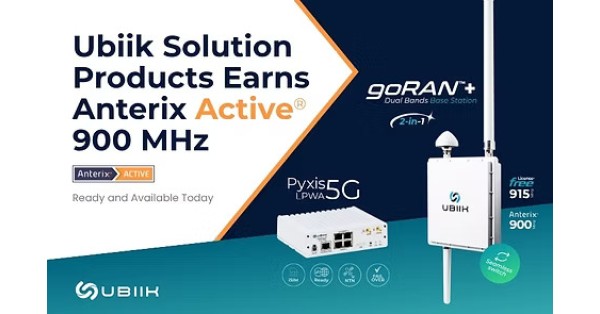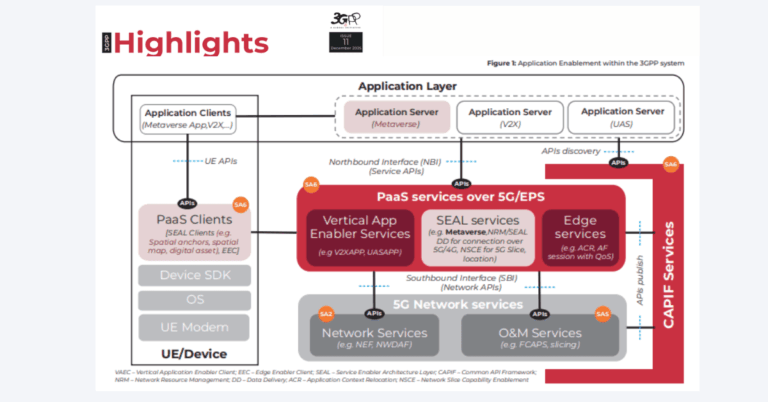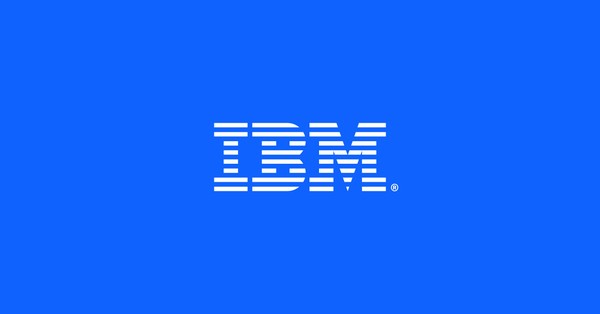Ubiik earns Anterix 900 MHz certification for private LTE
Ubiik has secured Anterix certifications for its router and base station, signaling readiness for private LTE deployments on Anterix’s 900 MHz Band 106 spectrum.
Certified devices: Pyxis routers and goRAN+ RAN
Anterix awarded Anterix Active badges to Ubiik’s Pyxis 5G LPWA RA810 router and its goRAN+ base station, confirming they meet Anterix operating criteria for 900 MHz private LTE. In addition, the high-power Pyxis RA320X variant received an Anterix Capable badge, validating a 28 dBm transmit option that extends reach compared to standard 23 dBm LTE modules. Together, the router and RAN designations give utilities and critical infrastructure providers a tested, end-to-end path to deploy pLTE on B106 across the 896-901/935-940 MHz band.
Why 900 MHz Band 106 strengthens utility private networks
Band 106 is licensed 900 MHz spectrum aligned with 3GPP LTE that Anterix has aggregated across the U.S., Puerto Rico, Alaska, and Hawaii. Sub‑GHz propagation improves coverage in rural and semi-rural territories, penetrates foliage and structures, and supports non-line-of-sight conditions common in grid and field operations. For utilities modernizing distribution automation, SCADA, and DER control, 900 MHz pLTE offers the combination of licensed interference protection, deterministic performance, and geographic reach that public networks and higher-frequency bands often struggle to match.
Strategic impact on utility private LTE deployments
The certifications reduce ecosystem risk while expanding architectural choices for mission-critical wireless modernization.
Sub‑GHz coverage and resilience benefits
The RA320X’s 28 dBm option can materially improve uplink margins, widen cell footprints, and reduce site density—important where vegetation and terrain complicate design and where truck rolls are expensive. At 900 MHz, utilities can create resilient field area networks that support latency-sensitive protection schemes and operational telemetry over wider areas with fewer gaps.
Interoperability and ecosystem risk reduction on B106
Anterix’s Active badge is more than a logo; it indicates lab-tested operation on B106 and interoperability with other ecosystem components. Ubiik’s Pyxis can slot into multi-vendor macro private networks or pair natively with goRAN+ for turnkey builds. That flexibility lets network teams mix best-of-breed elements—core, RAN, routers, and management—without locking into a single stack, an important lever for long asset lifecycles in the utility OT environment.
Edge OT/IT convergence with Pyxis 5G LPWA
Pyxis 5G LPWA is designed to bridge IP and non-IP equipment—supporting legacy serial/OT interfaces alongside Ethernet and IP-based applications—while adding edge compute on a dual-core ARM platform. This supports local decisioning, protocol translation, and resilience when backhaul is constrained, aligning with utilities’ push to move intelligence closer to devices, feeders, and DER nodes.
Design and deployment considerations for 900 MHz pLTE
The badges pave the way, but engineering choices around RF, architecture, and operations will determine ROI and reliability.
Power profiles, site density, and device mix planning
Plan coverage with both RA810 and RA320X profiles in mind. The 28 dBm variant can reduce the number of sites or harden links at the fringe, but verify EIRP constraints, antenna gains, and uplink budgets per jurisdiction. Balance high-power endpoints with standard-power devices to optimize costs across AMI, DA, teleprotection adjuncts, video, and mobile workforce use cases.
Architecture: macro private LTE vs localized cells
Ubiik’s equipment can support macro-style private LTE designs spanning large service territories or localized clusters around substations, depots, and industrial campuses. Match approach to terrain, fiber availability, and application SLAs; macro footprints simplify mobility and wide-area telemetry, while localized cells can concentrate capacity for feeder automation, FLISR, and DER management. Ensure the chosen architecture integrates with your chosen 3GPP-compliant core and OSS/BSS for provisioning, QoS, and observability.
Security and lifecycle management for utility OT
Align device onboarding, identity, and encryption with utility security frameworks and NERC CIP where applicable. Evaluate Pyxis edge capabilities for segmentation and policy enforcement at the device level. For multi-decade operations, prioritize vendors with clear roadmaps for 3GPP release updates, vulnerability patching, and field service tooling, and confirm interoperability testing across firmware versions within the Anterix Active Ecosystem (AAE).
What to watch next for Band 106 private LTE
Ecosystem maturity and application breadth will shape adoption velocity and economics for 900 MHz private LTE.
Band 106 device and module availability
Track the number of radios, modules, and embedded devices natively supporting B106, along with certification cadence through the AAE program. A broader device catalog reduces unit costs and accelerates field upgrades.
SCADA, DA, and DER application onboarding
Monitor real-world performance of SCADA backhaul, recloser control, capacitor bank automation, and DER telemetry on B106, including latency and jitter under load. Success here will validate pLTE as a unifying field network for OT workloads.
Integrating B106 with CBRS and public networks
Many utilities blend B106 with other options such as CBRS or public carrier roaming for coverage diversity and capacity bursts. Ensure devices, cores, and SIM/eSIM management systems can handle multi-band policies, QoS mapping, and failover without operational complexity.
The bottom line for 900 MHz private LTE
Ubiik’s Anterix Active and Capable badges strengthen the 900 MHz private LTE device and RAN ecosystem, giving utilities a tested path to licensed, resilient wide-area connectivity for mission-critical operations.
Key takeaways for telecom and utility leaders
Shortlist certified Band 106 solutions like Ubiik’s Pyxis and goRAN+ when designing private LTE for grid modernization. Use the 28 dBm option to trim site counts or harden edge links, insist on multi-vendor interoperability to future-proof investments, and design for OT/IT convergence at the edge to support SCADA, DA, and growing DER orchestration on a single, secure, licensed network foundation.








































